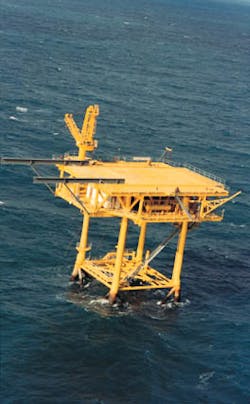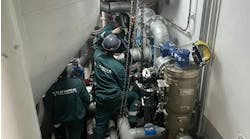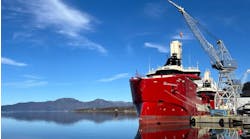Lack of organization complicates process
Bill Riles, Myron Van Kirk
Van Kirk & Riles Interests
This structure, Total Minatome's SMI 142 platform in the Gulf of Mexico, consists of a deck and jacket salvaged from separate facilities.
- The jacket of a used platform is pulled up in preparation for reburbishment. [36,067 bytes]
- Before photo shows the refurbishment of the used deck module before installation on Total Minatome's SMI 142 platform. [41,639 bytes]
- After photo shows the refurbishment of the used deck module before installation on Total Minatome's SMI 142 platform. [43,057 bytes]
Further, as international sources and markets for existing platform components develop, as site-independent floating deepwater development systems become available, and as information technology systems such as the Internet enhance definition and marketing, the global exchange of existing platforms will become significant. This article chronicles the history of Gulf of Mexico platform sales and examines current practices and global future trends.
History
In the Gulf of Mexico during the 1970s, some major operators repeatedly re-used drilling decks, while jackets and decks/production facilities were site and production-specific. Rarely were major platform components (jackets, decks, facilities) re-used or exchanged between operators.In the mid-1980s, with the deregulation of natural gas, the emergence of small independent operators, the availability of increasing numbers of decommissioned platforms, and development of smaller, short field life reserves, the re-use of platforms gained popularity.
Small independent operators - with limited capital and an interest in quickly developing small reserves (often with short field lives and in competitive situations) - sought every development cost and schedule advantage. With limited personnel resources (in numbers and in experience/expertise), independents looked to offshore contractors for solutions.
Initially, decommissioned platforms could be readily acquired. A contractor was often paid to salvage a platform and allowed to take ownership for the disposition responsibility. Beginning in 1987, Offshore Pipelines, Inc. (OPI) generated a significant portion of their business and quick growth from the turnkey salvage, modification and/or refurbishment, and re-installation of existing platforms and associated production equipment.
A contractor could generate market share by providing readily available turnkey services. Generally, these projects significantly accelerated development schedules and afforded financial advantages. However, low acquisition costs and best alternative option pricing techniques translated more to significant profits for the turnkey contractor than to savings for the operator.
The early technical, schedule, and financial successes of re-utilization projects created a growing industry segment. Regulatory bodies addressed guidelines for re-use. Brokers and entrepreneurs of varying description entered the market. Major and large independent operators sought investment recovery through partial realization of the residual value of existing assets and development advantage through the use of existing platform components.
The exchange of existing platforms gained an unsavory reputation in the offshore industry. The unorganized, unregulated, and uncontrolled sales activities made it difficult to distinguish legitimate transactions and participants.
The present
An operator with a decommissioning requirement must make many decisions, including determination of the re-usability of the platform. If the asset has no residual value and is not a candidate for re-use, traditional disposition options must be pursued. In the determination of value, alternative use options should not be ignored.For example, a Gulf of Mexico platform complex was recently sold in-place for use in a mariculture operation. If re-use is a possibility, several additional decisions must be made. Internal re-use is the most efficient means of re-utilization. However, if internal re-use is not an option, marketing must begin.
Early identification and marketing of candidate re-sale platforms increase the ultimate likelihood of sales:
- Mutual logistical advantages to the seller and buyer may be planned.
- More potentially applicable new development projects exist in a longer marketing window
- Considerable lead time may be required, depending on platform size, in consideration and contrast to custom design options.
Operators, as buyers and as sellers, recognize the value of quality existing platforms. They also recognize worldwide sources and markets for these components. They know the need for organization and knowledgeable marketing/procurement services to realize these values and markets.
Finding and selling
There are a number of sources of platforms in today's market, however, the same lack of organization seriously complicates the procurement and marketing processes. Marketing and procurement sources include operators, turnkey offshore contractors, turnkey project managers, brokers, investors, and, to a lesser degree, project management consultants All operators are sources of existing platforms or may need an existing platform for a development requirement (Other companies involved in the business are listed at the end of this article).Organization is the greatest obstacle to the identification of matching availability and requirements. There is no effective mechanism for the collection and distribution of data on available existing platforms and upcoming development requirements. Operators and marketing/procurement service companies must reach some common ground for the mutual benefit of all parties and the industry.
The lack of uniformity in representational control of properties is another key factor precluding efficiency in today's resale market. A seller must devote adequate resources to effectively market the components or engage a marketing agent to do so. The marketing agent must be contracted and compensated in a manner providing mutual objectives and incentives while precluding conflicts of interest.
A buyer must have confidence in the credibility of a marketing agent to fairly represent and to ultimately deliver the components. Similarly, many of the same factors conversely relate to procurement agents representing buyers in the acquisition of existing platforms. A broker without an agency relationship or some other form of representational control has conflicts of interest inconsistent with buyer and seller needs.
Storage considerations
Component storage is a difficult aspect of platform re-utilization. Project logistics, without significant prior planning and coordination, rarely allow coordinated salvage, refurbishment/modification, and re-installation operations by the seller and the buyer. Thus, storage of components is required.Fabrication contractors are hesitant to commit valuable real estate resources for undetermined time periods with little anticipation of significant future associated work. Thus, particularly for jackets, there are few viable storage options. Immediate scrapping and rigs-to-reef programs benefit. Often, because of storage considerations, it is economically advantageous to scrap or reef comparatively new jackets most valuable for re-utilization developments.
As in many industries, business biases adversely impact the re-utilization of platform components. Operator personnel, reluctant to compromise preferences, generally prefer custom designs. Engineering and project management contractors often prefer new designs for the enhanced labor requirements.
Likewise, fabrication contractors and equipment manufacturers prefer to sell their maximum efforts and new products. Operators must recognize these adverse influences to re-use and recycling and insist upon fair evaluation of re-use opportunities.
Platform condition
Purchasers must recognize several resale market generalizations:- A purchaser must realize that some degree of compromise is always required. No existing platform perfectly satisfies the operational requirements and technical specifications of another operator. However, considerable flexibility exists in all designs. Preference subjectivity must be prudently weighed against schedule savings and potential cost savings.
- A purchaser should not anticipate large capital savings in the re-utilization of a platform. Market factors and best alternative option pricing preclude most "steal" deals - more common in the past. The most significant advantage in the resale market is accelerated schedule - and consequent savings related to the time value of money associated with an accelerated production schedule.
- Careful due diligence consideration of condition, recertifiability, and applicability should be made. Almost all sales are made on an "as is, where is" basis. The axiom of "caveat emptor" or "let the buyer beware" applies. A number of quality platforms are being marketed by operators and/or professional agents. A lot of questionable components are being marketed by others. Operators must recognize the difference.
Schedule, cost savings
As previously mentioned, most re-utilization projects provide little capital expenditure savings - accelerated schedule is typically the most significant advantage. For like properties, refurbishment costs are inversely proportional to acquisition costs - extensive refurbishment or modification precludes schedule advantages.Ultimate development costs - with new construction, with inexpensively-acquired poor-condition existing platforms, and with more expensively-acquired good-condition existing platforms - approach like values. Schedules though may vary dramatically. Operators should focus purchase considerations on relatively new, good-condition existing platforms to fully realize re-use advantages.
Speculative investment purchase of platforms is rare and is limited to investors and occasionally to turnkey offshore contractors. Operators do not buy on speculation. This is in part a result of conservatism, risk aversion, and of the varied partnership interests within operators' developments.
However, operators' aversion of speculative purchases does retard the exchange of existing platforms by increasing the difficulty of mutual logistical operations in exchanges. Consequently, perfectly reusable components may often be scrapped rather than maintained awaiting a matching development opportunity.
Regulatory considerations
Regulations permit, but do not facilitate, the exchange of existing platforms. Recognition of the advantages and complications of the exchange of existing platforms needs to be reflected in regulatory requirements. For comparatively-new, readily-marketable platforms, allowing greater time for removal after the suspension of production would allow a greater opportunity for reuse.An operator often faces a subjective and arbitrary removal deadline forcing disposition decisions not always in the best interests of the industry, the environment, and all parties. Removal requirements have not been modified to reflect the growing practice of the re-use of platforms. What better place to temporarily store a platform than in-place. There would be opportunity to abuse the system, but if operators, contractors, and regulatory bodies work together, certainly there must be a way to enhance the recycling of platforms.
The future
A most significant future decommissioning consideration for operators will be investment recovery. Similarly, careful consideration of existing platform alternatives will be requisite for operator developments. Professional organizations providing comprehensive global marketing/procurement services will be necessary, and if effective, will be quite successful.Without such services, operators will be forced to devote valuable internal resources to these important topics. Trends are already developing in these directions. A major North Sea operator has recently assigned a dedicated investment recovery team to the disposition of platform components.
This team is currently selecting a contracting partner to professionally market components while maximizing investment recovery to partially offset decommissioning costs and balancing consideration of environmental, regulatory, media, and public interests.
The marketing and procurement of existing platforms demands professionalism, technological experience and appreciation, and the ability to blend offshore experience, communication skills (including information technology familiarity and utilization), marketing skills, and the art of selling to the benefit of all parties.
The industry is awakening to these requirements, but has limited options to meet these needs. All have heard the axiom "one man's junk is another man's treasure." However, an existing platform exchange requires several key ingredients:
- Informed and motivated seller
- Knowledgeable and willing buyer
- Accomplished and proven marketing/procurement agent
- Cooperative and understanding regulator
- Encouraging service industry
- Like timely needs.
Recycling contractors:
Turnkey offshore contractors, such as J. R. McDermott and Offshore Specialty Fabricators, maintain a limited inventory of existing platform components and production equipment to supplement their fabrication and/or installation operations and to be able to quickly respond to clients' turnkey development needs.Several companies package turnkey projects and subcontract refurbishment, fabrication, and installation operations, including but limited to, OPE, Bluewater, Cobb Offshore, and Engicon. Van Kirk & Riles Interests provides pure marketing and procurement brokerage services. WinMar Consulting and Twachtman Snyder & Byrd provide limited brokerage services complementing primary consulting activities.
Copyright 1998 Oil & Gas Journal. All Rights Reserved.




